
From Beaches to Caves: A Review of the Mountains & Coasts of South Wales Tour
Rabbie’s own Bron reviews the 3-day Mountains & Coasts of South Wales tour from Bristol.
There’s something about the start of a tour. You arrive at the pick-up location, bag waiting idly beside you, and you look around. There are others here – unfamiliar faces – the people you’re about to get to know. About to experience something special with. Maybe you’ll never see them again after this, or maybe you’ll be friends for life.
It’s a moment I’ve always quite liked. That ‘start of the trip’ thrill. The unknown.
So, I looked around at the unfamiliar faces and just went: “Here for the Rabbie’s trip?” And the spaced-out individuals and groups started inching their way closer together as we all realised... this was to be our little Welsh family.
There was the sweet-natured Johansson family, warm solo adventurer Lisa, energetic and inquisitive Ronnie from New Zealand, little old me, and our driver-guide Matt. With his good-natured spirit and hearty laugh, he was an easy person to like. Both our Bristol departures and Matt are new to Rabbie’s, and he brought the energy of someone who had finally discovered his ideal job. After years of dabbling in several industries, Matt found his place in the world – on the road with us.
And, as much as I hate this phrase, Matt had a can-do attitude. Lisa expressed her desire to see standing stones (being a huge Outlander fan) and, while none were included on the tour, Matt managed to find some nearby and squeeze it into the trip.
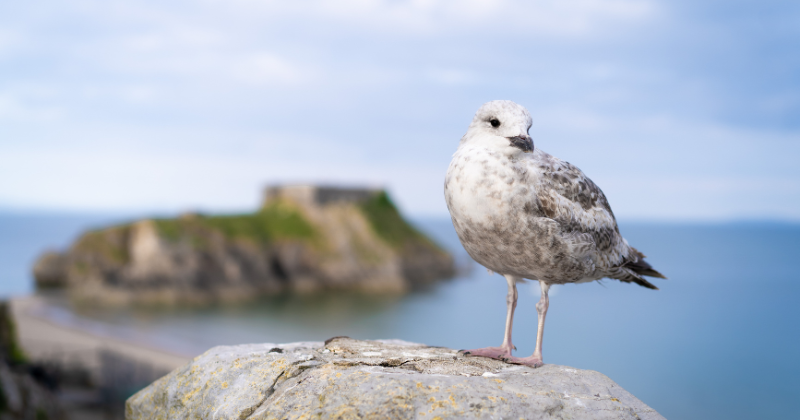
Day 1: St Davids, ruins & beaches
“Today is all about getting to St Davids.”
This is what Matt told us early on. But see – this is the thing I love about Rabbie’s tours... while St David’s was the highlight of the day, the before and after were pretty spectacular too.
Pulling up outside Caerleon, we weren’t sure if this striking ruin was going to be open. That’s the thing about travel – you have to be flexible. But the travel gods smiled down on us and two lovely ladies opened the gates. We flooded inside, blessed to be the only people exploring the ruins of this Roman amphitheatre.
This was the moment I bonded with Ronnie. Since she was from New Zealand and I from Australia. “We’re practically cousins”, she told me. Together, not only did we wander the ruins, we somewhat frolicked – clambering on the walls, testing our limits (safely), snapping pictures. It’s an imaginative kind of place and we were swept up in trying to get a feel for what it would have been like all those thousands of years ago. Perhaps we’d have been in the crowd, cheering on a bloody battle. Or perhaps we’d have been in the arena itself... though that sounds terrifying. We even tried to figure out where they would have kept the fighters and animals.
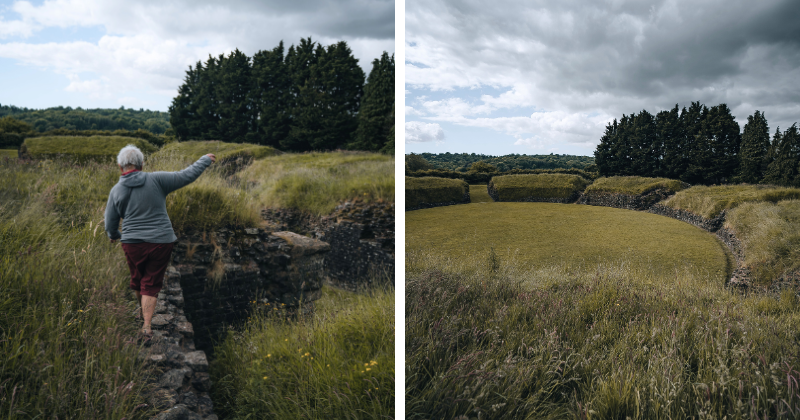
Already I knew I had found my travel buddy for the trip. But she wasn’t the only one. Lisa joined us on our next stop at this lovely little village called Narberth. It was the kind of place where locals sit on benches and watch the goings-on of the day. Where each shop is as unique as the next, many of which are tucked away down side streets.
We didn’t feel like sitting in a restaurant, so we grabbed takeaway from a local bakery and wandered the streets and shops for the next hour – getting to know the intricacies of our very different lives. And yet, here we all were – three solo female travellers, from three different countries (Lisa hailing from the USA). This is what I love about not only travelling solo but then joining a tour – because you’ll meet people you’d never normally meet. I know it sounds cheesy, but it’s true – and I’ve made some incredible friends over the years this way.
Then it was on to St Davids. Matt likes to do this thing where he parks up the bus and walks the passengers through the archway that reveals St Davids Cathedral. He wants the ‘oh wow’ moment – and he definitely got one. I was even filming at the time – and both Ronnie, Lisa & I can be heard making various exclamations.
It’s been a site of pilgrimage and worship for more than 800 years and we were happy to jump on that bandwagon. St David was known for being a passionate teacher. ‘Be joyful, keep the faith, and do the little things ...’ is something believed to have been said by him. The little things – like wandering the ruins of a cathedral with new friends.
And when St David died, his remains were kept at the cathedral and, in the 12th century, Pope Calixtus II declared it a place of pilgrimage. It was believed by Christians that by getting close to a saint, you would be closer to God. To this day, more than 300,000 people visit every year.
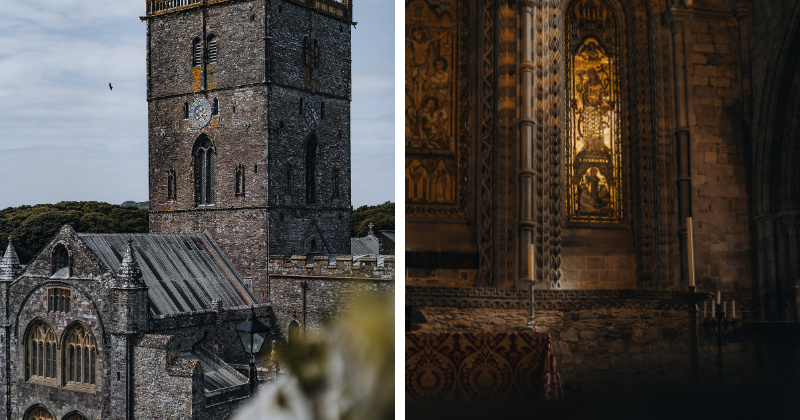
I’d seen photos of St Davids Cathedral before but somehow, they never did the buildings justice. Expansive, enormous, impressive... this was one cool spot. We were left to explore both the cathedral and the Bishop’s Palace – one a glistening beacon of religious wealth from history, the other the crumbling carcass of a once striking palace. The whole place had a way of making me feel very small and yet so spectacularly significant as I wandered the exposed rooms, imagining myself here before it was ruined.
I could have easily spent all day there but, after bumping into Lisa, we decided the cute city of St Davids needed exploring too. Fun fact: St Davids is the smallest city in the UK – and it can only be called a city because it is home to a cathedral.
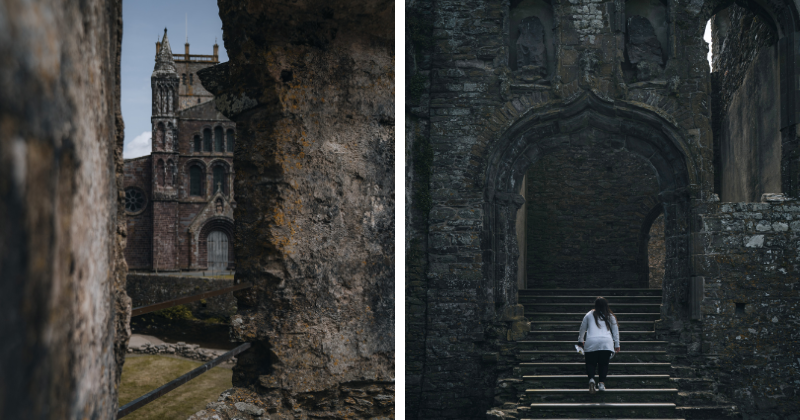
We made a beeline for the nearest ice-cream shop (recommended to us by Matt), where we ran into Ronnie. After cheers-ing our gelatos (as one does), we wandered the streets and resisted spending too much money.
As we carried on along the southern coast of Wales, Matt treated us to some stunning viewpoints and photo stops in the Pembrokeshire Coast National Park – a place I’d been looking forward to visiting for some time. 186 miles of stunning twists and turns, rugged clifftops and striking beaches, a coastline of true beauty. And while we didn’t see the complete 186 miles, what we did see was worth remembering.
People don’t think of Wales when you say the word ‘beach’ but I’m now of the opinion that Wales has some of the most stunning beaches I’ve ever seen – Newgale Beach being one of them. Even though the stops were quick, we always managed to have fun regardless.
Lisa and Ronnie helped each other take beach photos. The Johanssons were kind enough to allow me to snap a happy family photo. And Ronnie bonded with a local woman and her two dogs about to jump in for a swim.

One thing that strikes me about Wales is that most people I know have never been there, but it’s so often on their bucket list. People hear ‘Wales’ and think castles (since there are something like more than 600 in the country alone) and conjure up the image of a red dragon backed by white and green. And many chuckle at the complexity of the Welsh language. But being on the ground, meeting the locals, becoming part of the landscape, truly showcased the essence of Wales.
After swinging in at some (new) standing stones – previously mentioned – we arrived in Tenby. Why are they ‘new’? Well, most standing stones have mysterious backgrounds and are thousands of years old. But these stones were put here in recent years for a festival, and it was decided to leave them in place... and isn’t this exactly how ancient standing stones get their beginnings?
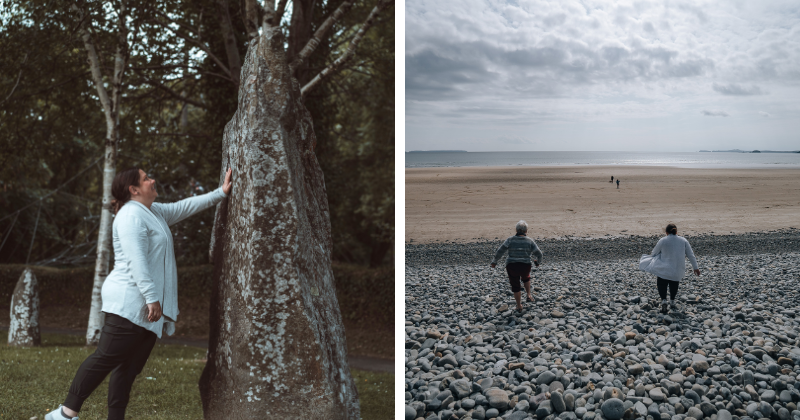
I am now confident that this is one of the loveliest little places I’ve been to and am dying to spend several weeks during the summer here. We were blessed with gorgeous weather for most of this trip (unheard of in Wales), and there was a moment the next morning when I was filming the beach from the viewpoint when I genuinely wasn’t sure how this could be Wales – and not the Caribbean instead. The water glistening blue, the sky perfected with fluffy clouds, the breeze gentle and cooling as the sun warmed my skin.
That night, Ronnie, Lisa and I stumbled into a local pub for some local delicacies. After a good chinwag, Ronnie headed down onto the beach for a sunset walk, while Lisa and I enjoyed the views from above.
Day 2: Castles, caves & beaches
Thank God (or Rabbie’s) that this tour makes room for time in Tenby on the morning of day two. I don’t think I could have left this town without exploring it more. I had a wonderful morning that started on the beach – where I forgot about a little thing called high tide and ended up having to hike up my skirt, hold my camera aloft, and wade through the shallows to make my way along the beach to a stairway back up to the ‘mainland’.
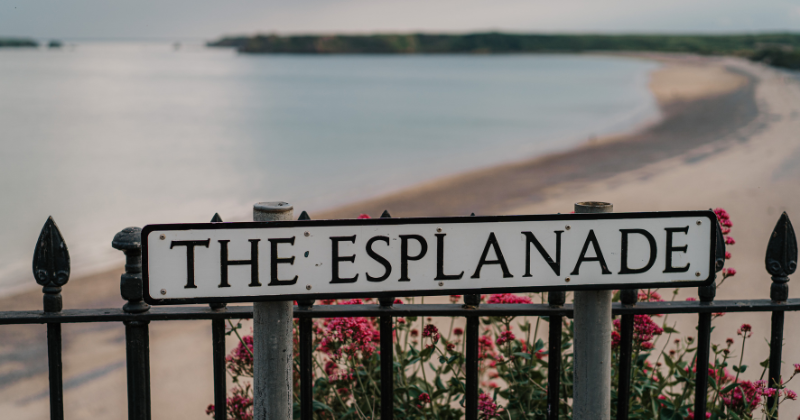
Though I could have stayed down on the beach for hours. Days, even.
But there was exploring to do. This little town is packed with quirky cafes tucked in little corners, stores and shop fronts to tempt you, and people all around you in various states of exploration. I was snapping a photo of this ruined archway when Ronnie appeared in my view finder – big smile and warm welcome.

And that’s the thing I realised about Tenby after my little wander. It’s quiet and peaceful, the perfect place for people to meander and feel this sense of belonging. A calmness washes over you – it certainly did for me. I passed by this woman at one point and, as we made eye contact, smiles blossomed on our faces and we agreed that Tenby was like something out a warm, seaside dream. I saw a mother and son with their dog, playing in the grass with a perfect view of the island and ocean. A husband and wife pushed their newborn down the cobbled streets, sunglasses on, an ease to their movements.
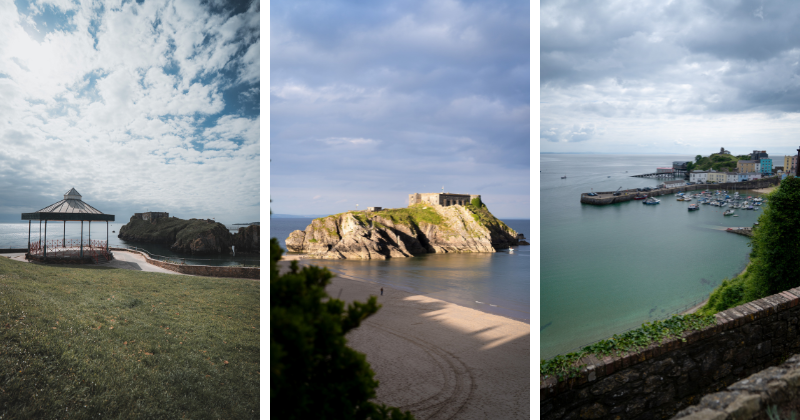
Tenby felt like a sanctuary from the bustle of a modern world, the kind of place you can go and take a few moments to breathe easy.
When we all piled onto the bus a few hours later, we agreed that Tenby was a new favourite place. We continued along the coast, stopping at a few more beautiful beaches for fresh air and photos.
The writer in me got a little thrill out of visiting Laugharne, the town where Welsh poet Dylan Thomas once lived. As we arrived in the car park, the castle loomed over us. Ruinous and still, it gazed heavily down on the marshland below, the water sparkling up at it as if trying to appease it. And people gathered in the space nearby to sell their wares at the marketplace with arguably one of the best views.
While the Dylan Thomas boathouse was closed, I was still able to have a stickybeak in through the window to see where this great writer used to work. I deduced that I needed a similar boathouse overlooking the water in which to write my novels.
The afternoon was a wonderful surprise. I knew we were to visit Carreg Cennen Castle, but I wasn’t anticipating the caves, the sheep, or the delicious meal.
This is everything a castle should be. Perched on a limestone crag overlooking the Welsh countryside. A dramatic ruinous silhouette commanding the view. Sheep scattered all around, like incredibly lax and adorable guardians of a once-great castle.
This is as wild and wonderful as castles come.
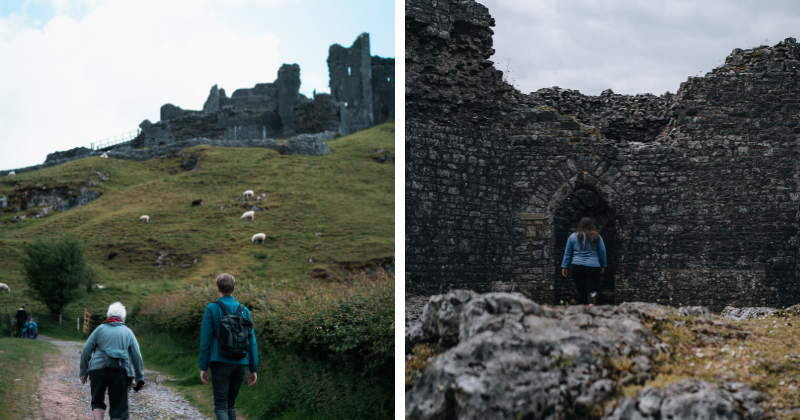
Before heading up to the castle, we stopped in at the cafe at its base and were treated to a local delicacy recommended to us by Matt. Welsh Cawl – a hearty vegan-friendly soup, so there’s really no excuse not to try it! Served with divinely soft bread and chunks of cheese, I have to say... I’m a fan.
After saying a quick hello to the nippy horses out front, we meandered our way up to the castle. I’ve got this cute photo of everyone with their heads bowed low – because the amount of sheep droppings made the walk there a bit of a mine field.
My favourite part of the castle was the caves, which I wasn’t aware of until I overheard someone mention them. And I was off! It didn’t matter that I was in a full-length skirt, flat open-toed shoes and carrying a load of camera equipment, I had to see this. Although, ‘see’ is a generous term. It was incredibly dark (as caves often are) but Ronnie and I decided to brave the depths of the labyrinth beneath the castle. It was such a little treat and I am so glad I took the time to go down there.
Down into the bowels of the castle we went, engulfed by the damp limestone caves. These caves occurred naturally beneath the castle, but additions and alterations were made, and many theories have arisen as to why. Perhaps as a means of gaining access to the water that collected in the cave?
Our day ended with a stunning drive through the bold landscapes of the Bannau Brycheiniog National Park (previously known as Brecon Beacons) before arriving in the quiet market town of Abergavenny.
Day 3: Books, valleys & abbeys
I feel like this day was specifically designed for me. As the person who often writes the tour itineraries for the website (yup, that’s me), I’d known about this tour for a long time and been interested in testing it out, and a big part of that is because of day three of this tour.
A big part of it was so I could see Hay-on-Wye up close. It’s known as the First Booktown in the World and as Matt walked us into the heart of town, bookstore after bookstore squeezed in beside markets and cute trinket-y stores and my wallet hid in anticipation.
World famous for housing an impressive number of secondhand and antiquarian bookshops, Hay-on-Wye is a book-lovers obsession. But for anyone with a love of quaint towns, striking architecture, buildings with timber frames, and local markets will adore Hay-on-Wye. The town even has a Norman castle, of all things. I wasn’t aware of this, so when I casually wandered past it, I was both shocked and delighted. The castle you see today was built over the top of a much smaller back around the year 1200 or so by a famously treacherous Norman Marcher Lord, William de Breos II. However, one legend states that the castle was rebuilt in a single night by his wife, Maud de St Valery, by carrying the stones in her apron. Go Maud!
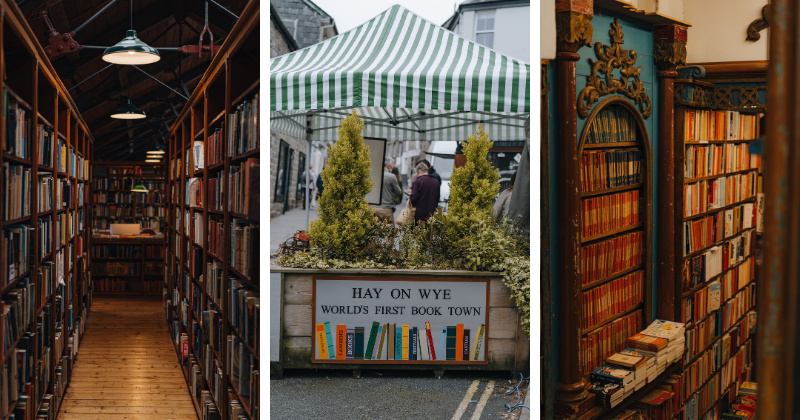
I have this obsession with collecting editions of Le Morte d’Arthur by Sir Thomas Malory (part of the Arthurian Legend), and so the hunt began... and ended quite quickly when the first bookstore informed me that their sister bookstore just down the road had a set of four pocket editions from 1898. Sold! As I made my way to this sister bookstore, I tried a few others out of sheer curiosity and sampled some of the local produce from one of the markets.
It was a sad, sad thing to leave Hay-on-Wye but there was more of Wales to be explored. Knowing Lisa’s love of ancient stones and my love of the Arthurian Legend, Matt added a quick extra stop not too far away: Arthur’s Stone. As we crested a small hill, to the left of the road, with the most incredible country view of rolling green hills, sat an enormous Neolithic burial chamber built of great stone slabs. Having just purchased my latest edition of Arthurian stories, I was one happy explorer.
As we continued our adventure, the roads turned windy and intimate. What I love about the country roads of Wales are the hedges that hug you either side. It should feel claustrophobic (there is no escaping!) but instead they were like something out of an Austen novel. Enjoying the view through the bus’ wide windows, I sat back and took in the lush greenery of Wales as we entered the Wye Valley.
This scenic route is considered the birthplace of British tourism and of the industrial revolution. With a quick lunch stop in the market town of Ross-on-Wye (ask your guide where to get the best local cheese), we fully embraced the beauty of Wye Valley.
Our final major stop of the day was Tintern Abbey in the heart of Wye Valley. The drive to get there was something else, let me tell you. Following the Wye River, surrounded on all sides by enormous blooms of green, I almost felt like I was on my way to Isla Nebula to visit Jurassic Park. It had that same kind of exotic, wild, yet beautiful feel to it. Luckily, no dinosaurs in sight.
Only Tintern Abbey. And only isn’t being generous enough because let me tell you, this abbey is a marvel even in its ruinous state. I can’t imagine what it might have looked like when it was first constructed back in 1131. The enormity of this abbey dominates the view as far as you can see, backed by brilliant Welsh green. Its Gothic appearance contrasts the luscious landscape around it but somehow it seems completely complementary.
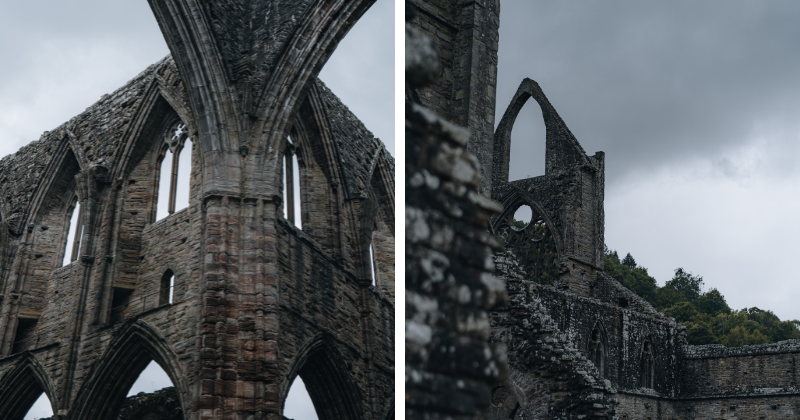
It was the first time on our trip when the Welsh weather gods decided to go back on their unspoken agreement with us to keep the weather pristine. However, I will say that the rain suited the abbey. Something about a downpour over a towering gothic masterpiece that really sets the mood. There was ample time to explore, for which me and my camera were grateful. I admit I’m a little jealous of the Cistercian monks who were lucky enough to live in such an incredible place, tucked along the splendour of a beautiful river in an even more beautiful valley. Tintern Abbey was a prime example of ‘they just don’t build things like they used to’.
It was a high to end on and by the time we reached Bristol, I was sad to say goodbye to Wales as much as my new friends. And while Wales may be a small country, it’s packed with treasures from monuments to histories, castles to legends. But that’s the thing about travel, there’s always the next adventure.






